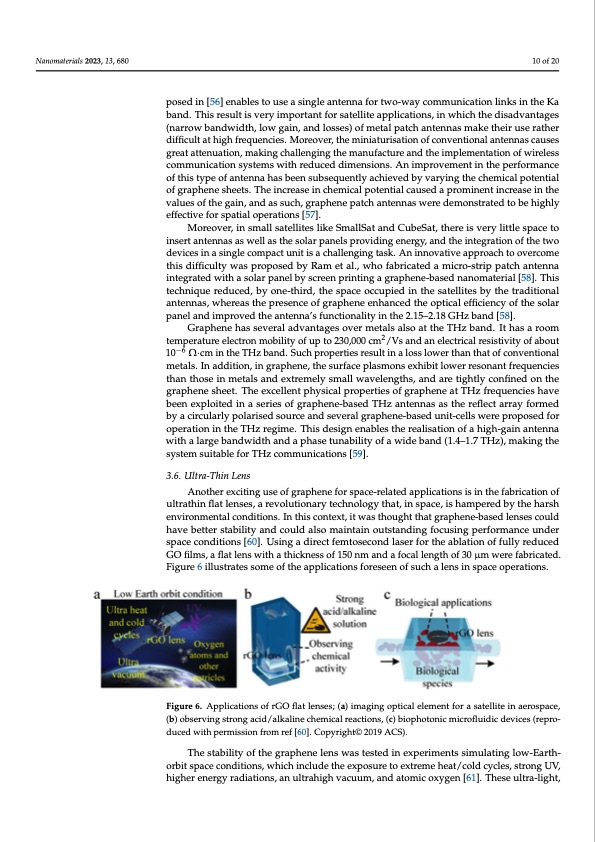PDF Publication Title:
Text from PDF Page: 010
Nanomaterials 2023, 13, 680 10 of 20 posed in [56] enables to use a single antenna for two-way communication links in the Ka band. This result is very important for satellite applications, in which the disadvantages (narrow bandwidth, low gain, and losses) of metal patch antennas make their use rather difficult at high frequencies. Moreover, the miniaturisation of conventional antennas causes great attenuation, making challenging the manufacture and the implementation of wireless communication systems with reduced dimensions. An improvement in the performance of this type of antenna has been subsequently achieved by varying the chemical potential of graphene sheets. The increase in chemical potential caused a prominent increase in the values of the gain, and as such, graphene patch antennas were demonstrated to be highly effective for spatial operations [57]. Moreover, in small satellites like SmallSat and CubeSat, there is very little space to insert antennas as well as the solar panels providing energy, and the integration of the two devices in a single compact unit is a challenging task. An innovative approach to overcome this difficulty was proposed by Ram et al., who fabricated a micro-strip patch antenna integrated with a solar panel by screen printing a graphene-based nanomaterial [58]. This technique reduced, by one-third, the space occupied in the satellites by the traditional antennas, whereas the presence of graphene enhanced the optical efficiency of the solar panel and improved the antenna’s functionality in the 2.15–2.18 GHz band [58]. Graphene has several advantages over metals also at the THz band. It has a room temperature electron mobility of up to 230,000 cm2/Vs and an electrical resistivity of about 10−6 Ω·cm in the THz band. Such properties result in a loss lower than that of conventional metals. In addition, in graphene, the surface plasmons exhibit lower resonant frequencies than those in metals and extremely small wavelengths, and are tightly confined on the graphene sheet. The excellent physical properties of graphene at THz frequencies have been exploited in a series of graphene-based THz antennas as the reflect array formed by a circularly polarised source and several graphene-based unit-cells were proposed for operation in the THz regime. This design enables the realisation of a high-gain antenna with a large bandwidth and a phase tunability of a wide band (1.4–1.7 THz), making the system suitable for THz communications [59]. 3.6. Ultra-Thin Lens Another exciting use of graphene for space-related applications is in the fabrication of ultrathin flat lenses, a revolutionary technology that, in space, is hampered by the harsh environmental conditions. In this context, it was thought that graphene-based lenses could have better stability and could also maintain outstanding focusing performance under space conditions [60]. Using a direct femtosecond laser for the ablation of fully reduced GO films, a flat lens with a thickness of 150 nm and a focal length of 30 μm were fabricated. Figure 6 illustrates some of the applications foreseen of such a lens in space operations. Figure 6. Applications of rGO flat lenses; (a) imaging optical element for a satellite in aerospace, (b) observing strong acid/alkaline chemical reactions, (c) biophotonic microfluidic devices (repro- duced with permission from ref [60]. Copyright© 2019 ACS). The stability of the graphene lens was tested in experiments simulating low-Earth- orbit space conditions, which include the exposure to extreme heat/cold cycles, strong UV, higher energy radiations, an ultrahigh vacuum, and atomic oxygen [61]. These ultra-light,PDF Image | Role of Graphene in Space Technology

PDF Search Title:
Role of Graphene in Space TechnologyOriginal File Name Searched:
nanomaterials-13-00680-v2.pdfDIY PDF Search: Google It | Yahoo | Bing
Salgenx Redox Flow Battery Technology: Power up your energy storage game with Salgenx Salt Water Battery. With its advanced technology, the flow battery provides reliable, scalable, and sustainable energy storage for utility-scale projects. Upgrade to a Salgenx flow battery today and take control of your energy future.
CONTACT TEL: 608-238-6001 Email: greg@infinityturbine.com (Standard Web Page)